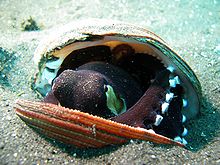


Blue Coconut Octopus
Amphioctopus marginatus, also known as the coconut octopus and veined octopus,
is a medium-sized cephalopod belonging to the genus Amphioctopus. It is found in tropical waters of the
western Pacific Ocean. It commonly preys upon shrimp, crabs, and clams, and displays unusual behaviour,
including bipedal walking and gathering and using coconut shells and seashells for shelter.

The main body of the octopus is typically around 8 centimeters (3 in) in size,
and, with arms, approximately 15 centimeters (6 in) long. The octopus displays a typical color pattern with
dark ramified lines similar to veins, usually with a yellow siphon. The arms are usually dark in color,
with contrasting white suckers. In many color displays, a lighter trapezoidal area can be seen immediately below the eye.
The coconut octopus is found on sandy bottoms in bays or lagoons.
It frequently buries itself in the sand with only its eyes uncovered.

Researchers from the Melbourne Museum in Australia claimed the creature uses tools for defense,
and uses available debris to create a defensive fortress. This behavior, observed in
Bali and North Sulawesi in Indonesia between 1998 and 2008, was published in the journal
Current Biology in December 2009. The researchers filmed A. marginatus collecting coconut half-shells,
discarded by humans, from the sea floor, carrying them up to 20 meters (66 ft), and arranging the shells
to form a spherical hiding place akin to a clamshell.
